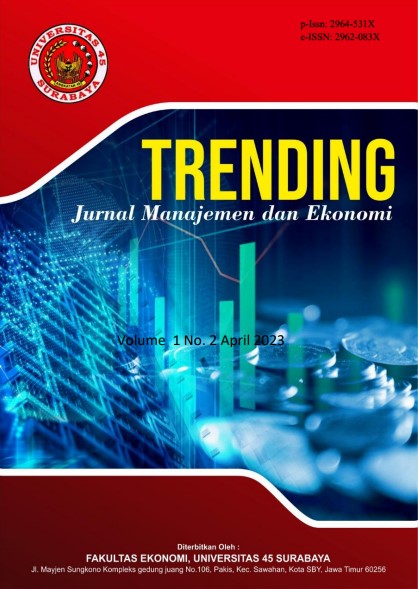Analisis Perencanaan Penerapan Enterprise Resource Planning (ERP) dalam Aktivitas Manajerial di Yayasan Sosial dan Pendidikan Bina Muda Cicalengka
DOI:
https://doi.org/10.30640/trending.v2i2.2270Keywords:
ERP, Information system, The Education FoundationAbstract
An Integrated Information System based on Enterprise Resource Planning (ERP) has become a tool that can be utilized to enhance the quality of organizational resource management, ensuring greater efficiency in achieving an organization's objectives. This research aims to analyze the technical planning aspects in the implementation plan of an ERP system within an educational foundation. The research employs a qualitative descriptive through interview techniques. The findings of this research indicate that the Bina Muda Foundation needs to prepare Hardware, Procedures, Policies, and People components among the eight main components required. The foundation's implementation plan for the new ERP can be outlined up to the fourth stage out of the ten stages, encompassing the analysis of needs, planning, ERP vendor selection, as well as configuration and adjustment. The benefits derived from the use of ERP include 1) enhancing foundation management governance, 2) expanding service sectors, 3) improving the school's image and community performance index, and 4) enhancing service quality in the education industry competition.
References
Abugabah, A, Sanzogni, L, & Alfarraj, O (2015). Evaluating the impact of ERP systems in Higher Education. The International Journal of Information and Learning Technology, emerald.com, <https://doi.org/10.1108/IJILT-10-2013-0058>
Bradford, M (2022). Modern ERP: select, implement, and use today's advanced business systems. Books.google.com, <https://books.google.com/books?hl=en&lr=&id=KZRqCAAAQBAJ&oi=fnd&pg=PR17&dq=modern+erp+select+implement+and+use+today%27s+advanced+business+systems&ots=G1tM63frGD&sig=FtzkzW_cHlDe0Jt13oYafJ9gTa0>
Fernandez, D, Zainol, Z, & Ahmad, H (2017). The Impacts of ERP Systems on Public Sector Organizations. Procedia Computer Science. Elsevier, <https://www.sciencedirect.com/science/article/pii/S1877050917311791>
Firlana, RA, & Suhendi, S (2020). Analisis dan Penerapan Enterprise Resource Planning (ERP) Odoo 10 guna membuat Laporan Keuangan pada Yayasan Darul Jannah. Jurnal Informatika Terpadu. journal.nurulfikri.ac.id, <https://journal.nurulfikri.ac.id/index.php/jit/article/view/264>
Josi, A (2016). Analisis dan Perencanaan Penerapan Enterprise Resource Planning (ERP) Pada Yayasan Prabumulih. Jurnal Informatika, jurnal.darmajaya.ac.id,<https://jurnal.darmajaya.ac.id/index.php/JurnalInformatika/article/view/946>
Laudon, KC, & Laudon, JP (2018). Management Information Systems: Managing The Digital Firm. Language.
Mkrttchian, V, & Stephanova, G (2013). Enterprise Resource Planning: Concepts, Methodologies, Tools, and Applications. Hershey: PA, IRMA & IGI Global.
Pemerintah Republik Indonesia. Undang-Undang (UU) No. 16 Tahun 2001 Tentang Yayasan. Jakarta.
Pusdatin, Kemendikbudristek (2023), Data Referensi Jumlah Yayasan Per Provinsi. Diakses pada 11 Juni 2023 dari https://referensi.data.kemdikbud.go.id/pendidikan/yayasan.
Romney, MB, Steinbart, PJ, Summers, SL, & Wood, DA (2021). Accounting Information Systems Enhanced EBook, Global Edition. Fifteenth. London: Pearson Education
Sari. I.N, Lestari. L. P, Kusuma, dkk (2022). Metode penelitian kualitatif. Books.google.com,<https://books.google.com/books?hl=en&lr=&id=iCZlEAAAQBAJ&oi=fnd&pg=PA177&dq=lestari+huberman+1984&ots=oohFQzvVXl&sig=vh_Dvj-ooTGIX9V_eZ3Fy70uqvE>
Sekaran, U., & Bougie, R. (2019). Research Methods for Business: A Skill-Building Approach (8th Edition). Wiley.
Downloads
Published
How to Cite
Issue
Section
License
Copyright (c) 2024 Trending: Jurnal Manajemen dan Ekonomi

This work is licensed under a Creative Commons Attribution-ShareAlike 4.0 International License.








